
BERKOWITZ: The colder you keep fish the better it maintains itself. So from the time it leaves the water and gets on a boat and is iced in, we have to make sure it’s always kept cold. It never comes in contact with heat until it goes right on the grill.
GELLERMAN: Today, two-thirds of the fish consumed in the United States is eaten in restaurants. And while the average American’s appetite for seafood has remained fairly constant over the decades -- about 15 pounds a year -- there are a lot more mouths to feed than ever before. And over-fishing has lead to the collapse of many fisheries.
Aquaculture, or fish farming, was once seen as the answer to the supply problem, and today a quarter of the fish served in the U.S. are farm-raised. But fish farming isn’t without its problems. It can pollute the sea, and toxins can accumulate in the flesh of farm-raised fish. So today, Roger Berkowitz says the future of the seafood industry in the United States hangs on the safety and sustainability of the resource.
BERKOWITZ: I know for a fact that if I ever put Chilean sea bass on my menu it would be one of the most popular fish I’ve ever done. I won’t do it. I’ve had it before -- it tastes delicious. But it’s not a sustainable fishery. Eighty-five percent of what’s being harvested now is illegal.
GELLERMAN: How much of the fish that Legal sells is farm-raised?
BERKOWITZ: Hmm, Good question. We see ourselves in the business of fresh fish, and I like the additional challenge of trying to get it wild as opposed to farmed. I’m trying to wean away from farm salmon to do more with Alaskan wild salmon: A, it’s a sustainable fishery. B, I think the flavor nuances are just spectacular. Now, I still use farmed product. I use Arctic char from Iceland, a spectacular farmed product. I use some farmed shrimp because it’s a much more consistent product than I can get on a wild product
GELLERMAN: There are many lists of fish to enjoy, fish to avoid. On the avoid list that I’m looking at it says, “shrimp: imported, farmed and wild” are to be avoided.
BERKOWITZ: Farmed and wild. Well, you know, there’s a glut of shrimp on market right now, so why would you avoid it.
GELLERMAN: They’re saying the farming of shrimp is a very polluting type of farming.
BERKOWITZ: Yeah, like anything else, let’s take a look at beef. There are great beef lots and there are poor ones. There are people who farm in a very sustainable method – you know, they don’t dump the effluent out without filtering it and taking care of it – and those who do a terrible job.
GELLERMAN: But how does the average consumer know that the farm-raised fish they’re buying was in a good farm or a bad farm?
BERKOWITZ: Well you know, it’s interesting. Consumers have more power than they know. They have the opportunity to vote with their feet. Go into a restaurant, ask for information about it.
GELLERMAN: If I went to the fish market where I go shopping, they’d look at me like I was from outer space! I mean, they’re lucky if they know if was farm-raised, let alone anything else.
BERKOWITZ: Well, if there were enough people going in there and asking the question, then they’d better wise up pretty soon.
GELLERMAN: To ensure safety and quality, Legal has it’s own high tech laboratory.
[BEEPS, LAB SOUNDS]
GELLERMAN: The place smells like the ocean. Every swordfish and tuna served at its restaurants is first sampled for mercury contamination.
[WHIR OF ROBOTIC ARM]
GELLERMAN: While Berkowitz says the health benefits from the fish far outweigh possible risks, the company’s mercury standards are tougher than the federal government’s. Steven Martinello carries a clipboard and wears a white lab coat. He’s Legals’ registered sanitarian.
GELLERMAN: You’re a registered?
MARTINELLO: Sanitarian. It’s a license you get from the state of Massachusetts. So actually you can enforce the public health laws of the state if you worked on a board of health.
GELLERMAN: Steve, you’ve got your microscopes, your analyzers, your test tubes and all that. I have a kitchen. How do I know what I’m buying?
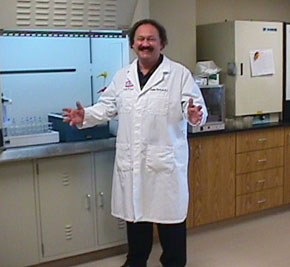 Steve Martinello, Legal Seafoods sanitarian (Credit: Legal Seafoods) Steve Martinello, Legal Seafoods sanitarian (Credit: Legal Seafoods)
MARTINELLO: You definitely want to buy off a licensed, reputable dealer, because they are licensed and they have to be inspected. As far as mercury content is concerned, if you ask your fishmonger the origin of the tuna, the origin of the sword, would help out a lot.
GELLERMAN: Where should I avoid buying it from?
MARTINELLO: Well, we find that we’ve had a little bit higher counts from areas from the South Seas. But places like Panama and Ecuador, and down by the Gulf, Louisiana and real close, are very very good.
GELLERMAN: What happens if you go over your limit? What do you do with that fish?
MARTINELLO: We send it back. We give it back to the vender.
GELLERMAN: But now he can give it back to somebody else?
MARTINELLO: Hmm. Possibly, yes. There’s an action level the FDA puts for mercury, but there’s no action to go along with that action level, because the decision of how dangerous mercury is for people has not really been decided on yet.
GELLERMAN: So you’re measuring this for the action level, but if it goes over that you really could do anything you want. You really could sell it legally.
MARTINELLO: Yeah we could, if we wanted to. But we don’t.
GELLERMAN: Infants and pregnant women are most at risk when mercury enters the food chain. That’s because mercury can damage developing nervous systems.
These MOMS – that’s short for Mothers Opposed to Mercury – went to the White House with a message that the Bush Administration’s proposed rule on mercury does little to reduce that risk.
[CROWD SOUNDS]
WOMAN: Just like tuna fish sandwiches – that’s what I made for lunch. And to think that I’ve been harming my kids all these years without any knowledge is a little devastating. But the fact that nothing is being done about it by the Bush Administration even makes me more infuriated.
[CHANTING CROWD: PROTECT KIDS’ FUTURES, NOT THE POLLUTERS! LOUDER! PROTECT KIDS’ FUTURES, NOT THE POLLUTERS!]
Related links:
- Seafood Choices Alliance
- Chef’s Collaborative
- Legal Seafoods Back to top
GELLERMAN: The Environmental Protection Agency plans to reduce mercury emissions from coal-fired power plants 70 percent over the next 15 years. But the proposal hit a nerve, and the EPA was flooded with public comments – the most in agency’s history.
Now the EPA says it will delay action on the rule while it reviews the comments. Most deal with whether a new technology to control mercury emissions can do the job. And if so, how soon? Living on Earth’s Jeff Young reports.
YOUNG: Lawmakers gathered near the capitol to look over stacks of cards and letters collected in opposition to EPA’s proposal for controlling mercury pollution. Some 450,000 people have commented and Connecticut Democratic Senator Joe Lieberman says most are telling EPA to try again on mercury.
LIEBERMAN: This rule has now become the most disapproved rule of any in the history of the EPA, and there’s good reason for it.
[APPLAUSE]
YOUNG: Lieberman and others demanded an explanation for how paragraphs from power industry memos showed up word-for-word in EPA’s proposal. They also want to know why the agency would wait more than a decade to implement what they call modest reductions in mercury. They claim technology already exists to make deeper cuts now.
EPA administrator Mike Leavitt told the national press club last month that he agrees the status of technology to control emissions is key to the mercury rule. But that’s where the agreement ends.
LEAVITT: Frankly, this is the issue on which this turns. I brought a panel of scientists and engineers together who not only understood this, they invented it. And they made clear to me that the new technology that we have such optimism on to reduce mercury from power plants is coming, but it will not be widely distributable or adequately tested until 2010. Those who say we can reduce it by 90 percent by 2007 are guilty of old thinking.
YOUNG: Leavitt’s remarks leave some key players in the business of pollution-control technology puzzled and dismayed. Dave Foerter is executive director of the Washington-based Institute for Clean Air Companies, which represents about 80 businesses making and marketing pollution-control equipment. Foerter says EPA’s top officials never asked for his input on the mercury rule.
FOERTER: We are the vendor community, or a good part of the vendor community, and we haven’t spoken directly to Leavitt on this and haven’t really been asked our opinion on it. So I just have to assume that who he’s been talking to are people who don’t have a vested interest in making this actually happen.
YOUNG: Foerter insists technology does exist that can cut mercury from coal power plants up to 90 percent. He points to a long-term test underway at the Southern Company’s power plant in Alabama showing good results at relatively low cost. And Foerter says a more aggressive EPA rule would spark more competition and creativity among companies, further lowering both costs and emissions.
FOERTER We have these things currently ready and the vendors are just chomping at the bit to sell these things. If we didn’t think we could do it we wouldn’t be out there pushing for these things to happen.
YOUNG: An EPA spokesperson calls the technology Foerter promotes hopeful, but says it still has kinks that must be worked out before it is commercially available. The agency wants the technology tested on all types of coal and boilers used across the power industry. Until then, EPA Chief Leavitt says, the technology’s performance can’t be guaranteed.
LEAVITT: When I sign rule, however, I have to deal with what’s real, not just what people who sell equipment say.
YOUNG: But some EPA insiders say the equipment salesmen are right. Bruce Buckheit retired as director of EPA’s air enforcement division just after the mercury proposal was announced. Buckheit says the agency’s own reviewers concluded years ago that deep mercury cuts were possible with existing technology. He’s suspicious of the agency’s new argument that the technology is not ready for prime time.
BUCKHEIT: If you go back a few years before these latest pronouncements and read what EPA was saying about these technologies and about what people knew, then you see a stark contrast. I think this is made up.
YOUNG: Buckheit’s input was not included in the agency’s mercury proposal. He says many career EPA employees were frozen out of the process while political appointees and the White house drafted the document.
BUCKHEIT: We learned of these new proposals the same as everyone else did, by reading about them in the paper. This was top down. The agency was given a decision and told to write it up.
YOUNG: So looking at this from the science side of things, is it science?
BUCKHEIT: Ah, no. Science is not the driver on policy decisions. The contacts with whoever talks to whoever at the white house drives that policy. Science is used to go find a justification for a decision that’s reached for other reasons.
YOUNG: The extended comment period gives EPA time to reconsider its assessment of the technology. Foerter, with the clean air companies, says that means he’ll finally get a 45-minute meeting with EPA’s deputy for air issues.
FOERTER: If EPA comes out and says the rule is based on there is no technology available, and I’m sitting here with vendors with licenses and everything else and they’re saying technology is available, then we need a meeting of the minds at some point. So 45 minutes for a meeting of the minds, that’s what I’m looking for.
YOUNG: We’ll learn if Foerter changes any minds at the agency when EPA presents its final rule on mercury next March. For Living on Earth, I’m Jeff Young in Washington.
Related links:
- EPA’s mercury web site
- The Institute of Clean Air Companies
- Northeastern States for Coordinated Air Use Management
- The Edison Electric Institute Back to top
GELLERMAN: To see one of the most remarkable small business success stories in Uganda, you have to duck -- or you’ll get caught in the laundry.
[BIRD SONG UP AND UNDER]
GELLERMAN: Clothes hang in the courtyard of Peace Byanduskya’s home in rural Kabale, Uganda. It’s here the 36-year-old mother of four runs “Blessing Abide Enterprises.” Last year, Peace was named Ugandan Business Woman of the Year. Beneath the laundry is her latest venture.
BYANDUSKYA: Solar dryers. Very expensive.
GELLERMAN: Filling her courtyard are desk-size solar dryers. Now, in developed countries, solar dryers are hardly extraordinary. But in rural southwest Uganda, the simple devices -- made of wood, covered in clear and black plastic -- are an innovative technology providing lives and livelihoods for hundreds of peasants.
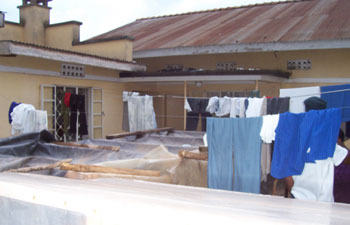 Solar dryers are set up in Byanduskya’s courtyard (Photo: Bruce Gellerman) Solar dryers are set up in Byanduskya’s courtyard (Photo: Bruce Gellerman)
Peace builds the dryers from plans supplied by the U.N. and uses them to dehydrate oyster mushrooms. Five years ago, Peace Byanduskya was selling used clothing when she decided to become an oyster mushroom mogul, and began teaching peasants how to grow them.
BYANDUSKYA: I want to encourage people to venture into this project, which doesn’t need big capital to begin. It needs minimal land. So I would encourage people to venture into this activity so that we can at least uplift our standard of living.
GELLERMAN: Why mushrooms?
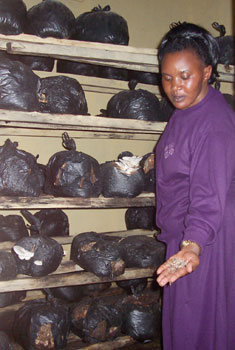 Byanduskya handles oyster mushrooms (Photo: Bruce Gellerman) Byanduskya handles oyster mushrooms (Photo: Bruce Gellerman)
BYANDUSKYA: They are nutritional. They are medicinal. They are easy to grow. And I basically wanted to deal with the rural communities, those people who are so unfortunate.
[CLINKING BOTTLES, SPRAYING WATER]
GELLERMAN: Peace’s son sorts empty pint whiskey bottles that she buys from local bars. The bottles are sterilized and filled with sorghum to grow the oyster mushroom spores.
BYANDUSKYA: I sell this bottle at one thousand.
GELLERMAN: This is like the world headquarters! [LAUGHS]
BYANDUSKYA: Yeah, it is. [LAUGHS]
 Peace Byanduskya at her home in Kabale, Uganda (Photo: Bruce Gellerman) Peace Byanduskya at her home in Kabale, Uganda (Photo: Bruce Gellerman)
GELLERMAN: Peace learned how to grow mushrooms at an extension course in Oregon. She started a demonstration plot in her home, and business literally mushroomed. Today, she provides the raw materials, the growing medium, and trains the people who teach peasants how to grow the fungus. For their labors, the peasants get about $2 for a kilo of fresh mushrooms, and $16 a kilo for dried. So far, 700 people have been trained. Six hundred are women.
BYUNDUSKYA: Mostly it deals with cooking, collecting water and firewood, and normally women do that work. But men also trying. Because I’ve now trained 38 trainers, and we have two men – which is good, to me. People outside have success stories. They are improving day by day, and I believe we shall be okay.
GELLERMAN: Peace Byunduskya, managing director of Blessing Abide Enterprises, Kabale, Uganda. For pictures of Peace, her mushroom dryers -- and yes, her laundry – check out our Web site: loe.org.
Back to top
GELLERMAN: Just ahead – new ideas in California rules spur a generation of vehicles that are greener than green. First this note on emerging science from Jennifer Chu.
[SCIENCE NOTE THEME]
CHU: The tuna-fishing industry first adopted “dolphin-friendly” fishing practices in the 1980s. Since then, the number of dolphins killed as by-catch has significantly dropped. But a corresponding recovery of the dolphin population has yet to follow, and no one knows why for sure.
A new study published this week in the Journal of Biology offers one explanation. An Israeli mathematician created a model to analyze the complicated-but-crucial bond shared between mother dolphins and their calves as they swim. Young dolphins position themselves to hitch a “free ride” in the mother’s wake in order to keep apace. In this way, they’re much like racing cyclists.
It works something like this: the wake, or “displacement” effect, creates a forward flow pattern. The calf can ride this wave with little effort. Meanwhile, the so-called Bernoulli suction effect draws the calf close to its mother’s side. Riding shotgun, up to 60 percent of the swimming work is done for the calves. They rely on this outside boost until about age three.
But fishermen can inadvertently break this mother/calf swimming bond during a tuna chase, as the mother accelerates to escape the boats. When this happens, a calf can become permanently separated from its mother and be lost. Research suggests that because of this premature separation, a significant number of young dolphins may be dying before they are able to breed.
That’s this week’s note on emerging science. I’m Jennifer Chu.
GELLERMAN: And you’re listening to NPR’s Living on Earth.
ANNOUNCER: Support for NPR comes from NPR stations, and: Aveda, an earth-conscious beauty company committed to preserving natural resources and finding more sustainable ways of doing business. Information available at Aveda dot com; The Noyce Foundation, dedicated to improving Math and Science instruction from kindergarten through grade 12; The Annenberg Foundation; and, The Kellogg Foundation, helping people help themselves by investing in individuals, their families, and their communities. On the web at wkkf.org. This is NPR – National Public Radio
Back to top
GELLERMAN: It's Living On Earth. I'm Bruce Gellerman.
So, how many miles a gallon does your car get? With gas prices soaring, high mpg’s have become the new status symbol…and if you want to wait a few decades carmakers say hydrogen powered vehicles will have you passing the joneses, without pollution. But if you can’t wait? Well, as Living on Earth’s Ingrid Lobet reports, auto-makers have already developed dozens of new clean cars that will leave you’re polluting neighbors in the dust.
(Loudspeaker at car dealership: Beep. Mrs. Gomez, your Corrolla is ready in service. Mrs. Gomez, please see the cashier.)
LOBET: You can't talk about today's clean cars without acknowledging one 50- mile per gallon car that's becoming almost common on the roads in California and Florida, though you might not see many yet in Boise or Milwaukee. It’s the gasoline-hybrid Toyota Prius.
ABRAMS: I'm Chris Abrams. The general sales manager of Hollywood Toyota. In Hollywood, on Hollywood.
LOBET: Chris Abrams has been watching the Prius become chic.
ABRAMS: Well Toyota of Hollywood is lucky to be in a demographic that makes us the number one hybrid electric dealer in the nation. We have Leonardo DiCaprio, Brad Pitt, Tom Hanks, Tony Shalhoub, Lucy Liu, Cameron Diaz...
LOBET: Abram's problem, in fact, is supply. Other dealers around the country have the same problem. They can't lay their hands on enough Priuses. The Toyota factory hasn't been able to keep up.
[FROM CAR LOT]
LOBET: So that's why I don't see many on the lot.
ABRAMS:No, no you don't. And the ones you do see are sold. If a truck pulled up right now and there were 200 Priuses, 300 Priuses on it, it would maybe fill the orders I have now…maybe.
LOBET: So if you don't mind waiting four months, the Prius is one nearly zero-emissions possibility and some 76 thousand Americans have bought them. Another 41 thousand have bought the Honda Civic hybrid. And about 12 thousand are zipping around in the sleek hybrid Honda Insight. That one's only a two-seater, so the appeal is limited. But you'll soon have many more than just these 3 hybrid choices.
Later this year there will be two new sedans in hybrid form: the Honda Accord and Nissan Altima. If you're looking for a pickup -- the Chevy Silverado and Equinox should be out later this year too.
But carmakers hope hybrid sales will jump out of the tens of thousands and into the hundreds of thousands when hybrid SUVs arrive…
[HIP HOP GROOVE, SOUND OF FORD COMMERCIAL]
 The Ford Focus PZEV, like all "PZEVs", emits less than 1 lb. of smog-forming pollutants in 15,000 miles. (Credit: AIC-Automotive Information Center) The Ford Focus PZEV, like all "PZEVs", emits less than 1 lb. of smog-forming pollutants in 15,000 miles. (Credit: AIC-Automotive Information Center)
LOBET:...like the new hybrid Ford Escape featured in this internet ad. A hybrid version of the Toyota Highlander SUV will be out in early 2005. And if Toyota is just a little down-market for your taste...
[STARRY MUSIC FROM LEXUS COMMERCIAL]
LOBET: Lexus is rolling out the first luxury hybrid SUV, and it won't even be marketed as a green car. Why emphasize miles per gallon, and global warming when you can talk about power and speed instead? This is the candid way Lexus puts it in an early ad for the Rx 400H.
ANNOUNCER: Today, at purchase, fuel economy is the last consideration of a Sport Utility Vehicle buyer. But it's the first dis-satisfier once they get the car home. In the case of the 400H we will sell performance and surprise with improved fuel economy.
LOBET: It's dawning on automakers that because electric motors reach full torque almost as soon as you switch them on, they can actually increase performance, or what some drivers think of as "that V-8 feel."
[QUIET ACCELERATION TO HIGH SPEED]
LOBET: Buying a hybrid still requires some commitment because they cost several thousand dollars more than their side-by-side non-hybrid brothers. But enough about regular old hybrids. Remember the all-battery car, the plug-in electric? There were a few made in the late 1990s, but Americans it seems weren’t much interested in a car that ran out of charge after 100 miles and needed to be plugged in. Living On Earth even aired a story about a funeral for the electric car idea last year in Los Angeles. But reports of the their demise may have been premature.
[SOUND OF NEIGHBORHOOD BASEBALL GAME]
LOBET: In his driveway in Redwood City, California, Felix Kramer admires his Prius.
KRAMER: I love it.
LOBET: But like so many of us, Kramer wants to change the thing he loves. He wants Toyota to build its next hybrids with bigger batteries and a plug so people who wish to can do all their daily driving without the gasoline engine ever kicking in. Not content with 50 miles per gallon, he wants to get 90. He wants something that doesn't exist right now--a plug-in hybrid.
|
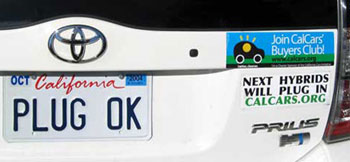 Felix Kramer's CalCars campaign hopes to persuade Toyota to make Priuses that travel farther on battery. (Photo: Felix Kramer) Felix Kramer's CalCars campaign hopes to persuade Toyota to make Priuses that travel farther on battery. (Photo: Felix Kramer) 
|
 KRAMER: Our point of view is you don't have to plug it in, you have the option of plugging it in. Conceivably you could go for months without going to a fueling station. And a lot of surveys have shown that going to gas stations is a very unpopular activity.
KRAMER: Our point of view is you don't have to plug it in, you have the option of plugging it in. Conceivably you could go for months without going to a fueling station. And a lot of surveys have shown that going to gas stations is a very unpopular activity.
LOBET: Kramer has helped organize a whole community of fellow "pluggies,” online. They've pored over every nook and cranny in their Priuses, and they’ve discovered certain hints that lead them to believe Toyota might just be considering the plug-in option, too.
[CAR DOORS SLAM]
KRAMER: To the left of the steering wheel is a black button that is blank. That is the magic EV-only button. In Europe and Japan, if you push that button the car is a pure electric vehicle. The existence of this EV button has inspired a tremendous amount of discussion online about what would it take to make the Prius a plug in electric vehicle.
LOBET: And there's another curiosity at the back of the car.
[CAR DOORS CLOSE]
LOBET: So we're going back around to the trunk.
[SOUND OF HATCHBACK OPENING]
KRAMER: The Prius is a hatchback ...and there is a hidden compartment in the Prius.
LOBET: a hidden compartment.
KRAMER: First I take out the carpet. And there's a pretty substantial area down here ...
[SOUNDS OF PUTTING THINGS BACK]
LOBET: It’s a nice empty space where a beefed up battery could go in a future version. Or maybe it's just a convenient place to hide a camera from view.
LOBET: I have to mention here one other thing Felix Kramer and other drivers of electric vehicles and hybrid vehicles love about their cars, and that's regenerative breaking. With regenerative breaking, you put your foot on the break and the energy of the wheels spinning against the breakpads recharges the battery. When you break, you watch the charge on the battery rise.
[SOUNDS OF NEIGHBORHOOD BASEBALL GAME]
We stand in his driveway and I ask Felix why he's dedicating so much time to making a very clean advanced car into a more electric car.
KRAMER: We think something really new could happen from this CALCARS campaign. You could get a large group of organized consumers defining what kind of product they need and demonstrating to the manufacturer that there is demand for that vehicle. And really changing the world by saying this is what we want. We're willing to pay for them, please make them for us.
[SOUND OF KIDS PLAYING, MIXED WITH CHIMES AT KRAMER’S HOUSE]
LOBET: I wondered what engineers might say to the idea of a next generation of plug-in cars at a time when it seemed like plug-ins have been superceded. Robert Graham and Mark Duvall are both engineers and managers at the Electric Power Research Institute in Palo Alto. The Institute develops everything from nuclear plants to batteries for the power industry. Of course, the power industry would like everything to plug in, but even power company critics agree, gallon for gallon of fuel, electricity is a much cleaner way to run vehicles. And Duvall believes hybrids that can plug in are definitely on the way.
DUVALL: A conventional midsize car gets 27 miles per gallon. That's what the federal government mandates, and so that’s what it is. A car like a Toyota Prius gets about twice the fuel economy of a conventional mid-size car. A plug-in hybrid mid-size car would cut that in half again, so you 'd be down to a quarter of the fuel consumption of a conventional car. So it's really a dramatic difference, and it's the type of difference that you need if we’re actually going to reverse our consumption of petroleum
LOBET: How much does it cost to juice the battery up at night, and how much compared to just letting the hybrid gas motor charge the battery?
DUVALL: If you had a plug in hybrid and it drove 20 miles a day on electricity and it was a mid-sized car, you would need less than 50 cents to charge it, per charge. So every day you drive to work and back, and that 15 dollars a month at today’s prices would replace about 60 dollars in gasoline.
LOBET: And what do they make of the EV button and that extra hidden space in the Prius--is it a clue that Toyota might consider producing vehicles that run longer distances on battery only? Bob Graham.
GRAHAM: I'm convinced that Toyota already has a plug-in hybrid design ready to bring to the marketplace because it's a logical next step. They see, as I do, an urban America that wants a clean vehicle in downtown America, or downtown Europe. It makes good logical sense to have a hybrid and a plug-in hybrid together as a family of vehicles.
LOBET: Part of what convinced Graham about hybrid plug-ins was a project, now underway and still under wraps at DaimlerChrysler in Germany. They’re making a plug-in hybrid version of the Dodge Sprinter delivery truck. That’s the first time a major car manufacturer has committed to doing a plug electric hybrid vehicle. While DaimlerChrysler is still only building the first 30, Graham says for him, it's a reality.
GRAHAM: I don't see any reason why this vehicle will not get commercialized. There's no technical hurdles, there’s no market hurdles, there’s some volume hurdles, but we think the market demand will overcome that. I can't think of a single reason why we won’t be successful today. If you asked me that same question two years ago, it would have been a different story, but there are no reasons why we will not be successful today.
 Toyota has paired with AC Propulsion of California to make an all-electric version of this Scion XB. (Credit: Toyota Motor Corporation) Toyota has paired with AC Propulsion of California to make an all-electric version of this Scion XB. (Credit: Toyota Motor Corporation)
LOBET: So there you have that option. Some people are excited about marrying the hybrid car to the optional plug-in. But improvements in battery technology could mean that even the pure battery electric vehicle could rise from the crypt. Recently on David Letterman, actor Tom Hanks, who has an electric car and a Prius, revealed that he has invested money in AC Propulsion--a respected Los Angeles electric car builder. It turns out that Toyota, in partnership with AC Propulsion, plans to build an all electric, plug in version of its boxy Scion xB.
HANKS: Now here's the great thing, the greatest thing about driving an electric car Dave, and I know I say Dave a lot. It's because you still scare me Dave, you really do. Is that you never have to stop at the gas station again. You want to talk about freedom, America? You never have to stop at a gas station again. Except when you really want a Big Gulp and some Slim Jims.
[APPLAUSE]
LOBET: There's also another clean car possibility already on the market, and that's natural gas. Honda makes a natural gas version of the popular Civic. We caught up with Honda's Annabel Cook as she was making a presentation to people who buy lots of cars, fleet managers.
COOK: So there's the Civic. It looks like any other Civic. It's actually built on the same assembly line as the gasoline vehicles. And it's built in Ohio. Now why did we go natural gas? Natural gas is less expensive than gasoline. Right now at some stations it’s about $1.34 a gas gallon-equivalent. It's also of course much cleaner. And as a technology it's becoming more and more available.
LOBET: Up until now natural gas vehicles have mostly been sold to taxi companies and cities and counties, people who can gas up at their own pump. But the number of natural gas pumps is growing. There are 1300 in the United States, 220 in California. And if Honda has it's way, you'll soon be able to fill up your natural gas car at home in your garage with a hose connected to a wall box that in turn is connected to your gas meter, the same one you use for your stove.
COOK: And that's what the unit looks like, it's about the size of a pay telephone, and this appliance will able to be placed in your garage, it will tap into your gas line that’s already going into most your homes, and it will allow you to fill your vehicle overnight.
LOBET: Honda now hopes to start selling the boxes in the fall at about one to two thousand dollars each.
So we've mentioned natural gas, pure battery cars, plug-in hybrids, as well as the standard hybrids, with no plug. But there's one other clean car option. And it might be the biggest surprise. In struggling to meet California's strict air rules, major car makers have figured out ways to tweak the plain old gasoline car and make it super clean. At least nine automakers are making such next-gen versions of their cars including the Ford Focus, Toyota Camry and BMW 325i. Professor Jim Lents of the University of California at Riverside helped run the first tests.
LENTS: They are so clean that on a few occasions when we’ve been out on the freeway making measurements, they actually produce cleaner air out the tailpipe than is coming in the intake of the engine, so one could argue they are actually cleaning up the air. This is a rare occasion but it’s interesting even if it happens at any point on time.
LOBET: It's hard for many people to believe that engineers have been quietly reducing tailpipe smog by another 90%, the more visible trend has been SUVs. But Lents says the breakthroughs happened with almost all the manufacturers.
LENTS: The computer- the microprocessor came, it allowed gasoline to be more accurately distributed to the cylinders and air to be produced exactly in the right amount for the combustion process and to cause the spark plugs to fire at the right amount.
LOBET: California air officials predict six times as many of these 'PZEVs' or partial zero emissions vehicles as hybrids will be made next year. They don't get the good mileage you can get with the hybrids, so you’ll probably still be going to the gas station just as often. But they’re probably the cheapest route to cleaner air, fifteen thousand dollars for a Ford Focus at the lower end. The bottom line: you don't have to wait for the fuel cells to have a pretty broad choice of clean cars. For Living On Earth, I'm Ingrid Lobet in Los Angeles.
GELLERMAN: You can check out a complete list of the new generation of clean cars available today at our website: Living on Earth dot org.
Related links:
- Drive Clean
- The California Cars Initiative
- AC Propulsion, Inc. Back to top
GELLERMAN: And for this week - that's Living on Earth. Next week – There’s a lot of talk lately about hydrogen as the next, big thing in energy…some skeptics say it’s decades away and will never be too cheap to meter. But on a small island in the middle of the North Atlantic the idea is more than a lot of hype. In Iceland, hydrogen is already happening.
MALE: Can the world afford to have the hydrogen project far into the future? Isn’t it of great need, even pressing need, for the total global environment to have the hydrogen project as a viable option, here and now, as quickly as possible?
GELLERMAN: It’s the “Promise of Hydrogen” - on the next Living on Earth. And between now and then you can hear us anytime and get the stories behind the stories by going to Living on Earth dot org. That’s Living on Earth dot O-R-G.
[EARTH EAR: “Cricket Voice”]
And by jimminy, We leave you in the Mexican desert with a lone cricket. Hildegard Westercamp recorded this insect’s song…took it back to her studio and used it to frame her composition called: “Cricket Voice.”
GELLERMAN: Living on Earth is produced for the World Media Foundation by Chris Ballman, Christopher Bolick, Eileen Bolinsky, Jennifer Chu, Ingrid Lobet, Susan Shepherd and Jeff Young. You can find us at Living on Earth dot org. Our technical Director is Paul Wabreck. Alison Dean composed our themes. Special thanks to Ernie Silver and Carl Lindemann. Environmental sound art courtesy of EarthEar. Steve Curwood is back next week. I’m Bruce Gellerman. Thanks for listening.
ANNOUNCER: Funding for Living on Earth comes form the National Science Foundation, supporting coverage of emerging science; and Stonyfield Farm – organic yogurt, cultured soy, and smoothies. Ten percent of their profits are donated to support environmental causes and family farms. Learn more at Stonyfield.com. Support also comes from NPR member stations, the Ford Foundation, for reporting on U.S. environment and development issues, and the William and Flora Hewlett Foundation, for coverage of western issues.
NPR ANNOUNCER: This is NPR, National Public Radio.
Living on Earth wants to hear from you!
Living on Earth
62 Calef Highway, Suite 212
Lee, NH 03861
Telephone: 617-287-4121
E-mail: comments@loe.org
Donate to Living on Earth!
Living on Earth is an independent media program and relies entirely on contributions from listeners and institutions supporting public service. Please donate now to preserve an independent environmental voice.
NewsletterLiving on Earth offers a weekly delivery of the show's rundown to your mailbox. Sign up for our newsletter today!
 Sailors For The Sea: Be the change you want to sea. Sailors For The Sea: Be the change you want to sea.
 The Grantham Foundation for the Protection of the Environment: Committed to protecting and improving the health of the global environment. The Grantham Foundation for the Protection of the Environment: Committed to protecting and improving the health of the global environment.
 Contribute to Living on Earth and receive, as our gift to you, an archival print of one of Mark Seth Lender's extraordinary wildlife photographs. Follow the link to see Mark's current collection of photographs. Contribute to Living on Earth and receive, as our gift to you, an archival print of one of Mark Seth Lender's extraordinary wildlife photographs. Follow the link to see Mark's current collection of photographs.
 Buy a signed copy of Mark Seth Lender's book Smeagull the Seagull & support Living on Earth Buy a signed copy of Mark Seth Lender's book Smeagull the Seagull & support Living on Earth
| | 
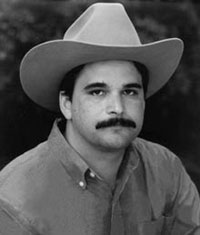
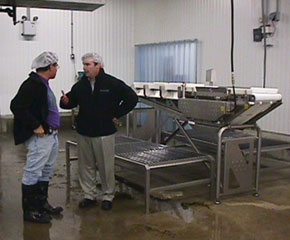
 Steve Martinello, Legal Seafoods sanitarian (Credit: Legal Seafoods)
Steve Martinello, Legal Seafoods sanitarian (Credit: Legal Seafoods)  Solar dryers are set up in Byanduskya’s courtyard (Photo: Bruce Gellerman)
Solar dryers are set up in Byanduskya’s courtyard (Photo: Bruce Gellerman) Byanduskya handles oyster mushrooms (Photo: Bruce Gellerman)
Byanduskya handles oyster mushrooms (Photo: Bruce Gellerman)  Peace Byanduskya at her home in Kabale, Uganda (Photo: Bruce Gellerman)
Peace Byanduskya at her home in Kabale, Uganda (Photo: Bruce Gellerman)  The Ford Focus PZEV, like all "PZEVs", emits less than 1 lb. of smog-forming pollutants in 15,000 miles. (Credit: AIC-Automotive Information Center)
The Ford Focus PZEV, like all "PZEVs", emits less than 1 lb. of smog-forming pollutants in 15,000 miles. (Credit: AIC-Automotive Information Center)  Felix Kramer's CalCars campaign hopes to persuade Toyota to make Priuses that travel farther on battery. (Photo: Felix Kramer)
Felix Kramer's CalCars campaign hopes to persuade Toyota to make Priuses that travel farther on battery. (Photo: Felix Kramer)  Toyota has paired with AC Propulsion of California to make an all-electric version of this Scion XB. (Credit: Toyota Motor Corporation)
Toyota has paired with AC Propulsion of California to make an all-electric version of this Scion XB. (Credit: Toyota Motor Corporation) 



